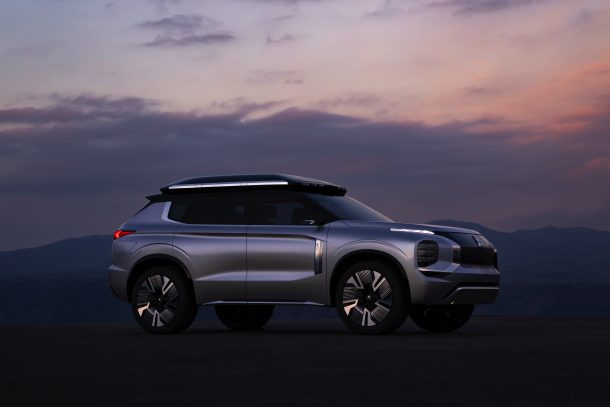Mitsubishi's Crossover Concept Looks Bold - Yeah, That's the Ticket

It might not be your author’s cup of tea, but Mitsubishi’s Engelberg Tourer — a crossover show vehicle whose name sounds like that of a nagged German child — is the face the resurgent brand wants to put forward.
It’s also a good hint at what we can expect from the next-generation Outlander, once Mitsu gets around to revamping its largest model.
We’ve explained the name already, so read this for background. The Engelberg Tourer has nothing to do with Teutonic angels or Karl Marx’s buddy, and a lot to do with skiing and other sexy outdoor sports. Mitsubishi says it wants this crossover to stir your curiosity.
Are you feeling stirred?
Bearing three rows of seats and wheels that look like blade attachments for a food processor, the Engelberg Tourer draws its power from a plug-in hybrid powertrain comprised of two electric motors and one 2.4-liter inline-four. The system can operate as a series hybrid, with the gasoline motor acting as a generator for the electric motors (located fore and aft). Estimated electric driving range is 43 miles.
Sexy off-road adventures are made possible by the twin-motor setup’s full-time four-wheel drive capability, aided by Mitsu’s Super All-Wheel Control (S-AWC) system, which applies braking force at various corners to keep things from getting too hairy.
You can also stash your gear in that roof box. It opens via a switch, not a latch.
Mitsubishi used the Engelberg Tourer’s appearance at the Geneva Auto Show to talk up the Dendo Drive House, which is not a socialist podcast popular with East Coast Millennials. DDH for short, the system is a complete package for green drivers, encompassing the vehicle itself, a bi-directional charger, solar panels, and home battery designed for home use. The idea is to be able to charge your Mitsubishi PHEV or EV from home using just the sun.
While this could prove useful for preppers, the automaker plans to offer it (initially, at least) only in Europe and Japan. Bummer.
As for the vehicle this show car could become, Mitsubishi’s product timeline isn’t all that clear. Automotive News claims an Outlander redesign may come for the 2020 model year. If that’s the case, expect to see a variation of this vehicle’s face, plus its boxy proportions and sharply raked rear glass, in the showroom before too long.
[Images: Mitsubishi Motors]

More by Steph Willems
Latest Car Reviews
Read moreLatest Product Reviews
Read moreRecent Comments
- Mike-NB2 This is a mostly uninformed vote, but I'll go with the Mazda 3 too.I haven't driven a new Civic, so I can't say anything about it, but two weeks ago I had a 2023 Corolla as a rental. While I can understand why so many people buy these, I was surprised at how bad the CVT is. Many rentals I've driven have a CVT and while I know it has one and can tell, they aren't usually too bad. I'd never own a car with a CVT, but I can live with one as a rental. But the Corolla's CVT was terrible. It was like it screamed "CVT!" the whole time. On the highway with cruise control on, I could feel it adjusting to track the set speed. Passing on the highway (two-lane) was risky. The engine isn't under-powered, but the CVT makes it seem that way.A minor complaint is about the steering. It's waaaay over-assisted. At low speeds, it's like a 70s LTD with one-finger effort. Maybe that's deliberate though, given the Corolla's demographic.
- Mike-NB2 2019 Ranger - 30,000 miles / 50,000 km. Nothing but oil changes. Original tires are being replaced a week from Wednesday. (Not all that mileage is on the original A/S tires. I put dedicated winter rims/tires on it every winter.)2024 - Golf R - 1700 miles / 2800 km. Not really broken in yet. Nothing but gas in the tank.
- SaulTigh I've got a 2014 F150 with 87K on the clock and have spent exactly $4,180.77 in maintenance and repairs in that time. That's pretty hard to beat.Hard to say on my 2019 Mercedes, because I prepaid for three years of service (B,A,B) and am getting the last of those at the end of the month. Did just drop $1,700 on new Michelins for it at Tire Rack. Tires for the F150 late last year were under $700, so I'd say the Benz is roughly 2 to 3 times as pricy for anything over the Ford.I have the F150 serviced at a large independent shop, the Benz at the dealership.
- Bike Rather have a union negotiating my pay rises with inflation at the moment.
- Bike Poor Redapple won't be sitting down for a while after opening that can of Whiparse




































Comments
Join the conversation
Let it be noted that design staffs have taken a severe dislike to the traditional dogleg. RIP, dogleg. B-pillar blackout has overtaken the A-pillar. Headlights have split into two factions, with the upper set relentlessly inching toward the A-pillar (see esp. the first picture). One wonders if the coming collision between light and darkness will result in matter/antimatter-style annihilation.
By gum, it's an Outlander PHEV, only this time with a useful amount of electric range, a less overstressed generator, and fashionably Kia Telluride / Lego Brick styling. Shoot howdy, I'd certainly be open to leasing one. (Tho that flat tall front has got to be murder on highway efficiency.)